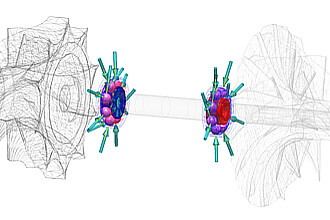Analysis of the dynamical behaviour of turbocharger rotors supported in ball bearings
Projektleiter:
Projektbearbeiter:
Dr.-Ing. Christian Daniel
Finanzierung:
Industrie;
Forschergruppen:

Turbochargers are essential elements in the downsizing concept of recent combustion engines. One major development objective is to raise the maximum rotor speed to either increase the air-mass flow or decrease the design size. This causes, among mechanical strength issues, inadequate subsynchronous vibrations known as fluid-whirl and fluid-whip for turbochargers equipped with journal bearings. Another disadvantage of commonly used journal bearings is the rather high friction loss, which is a significant design parameter. To overcome these problems ball bearings concepts are most suitable for advanced designs.
In that context, the simulation of the rotor including the non-linear effects of ball bearings, (with additional squeeze film damper to assure sufficient damping) is essential for an apriori analysis of the system’s dynamics. For that purpose, a dynamic model of the ball bearings including the contact dynamics between the balls, the inner and outer bearing raise and the cage was established and is investigated in detail.
The ball bearings and the squeeze film dampers are implemented with high modelling depth, taking into account all relevant design parameters like initial load, contour of the ball bearings, seals of the squeeze film damper etc.. The system’s eigenbehaviour is investigated using a non-linear and a linearized approach for the stiffness and damping properties of the bearings.
Finally, the results in term of time dependent rotor displacements (under a given rotational frequency of the turbocharger) are examined and compared with measurements to validate the simulation model.
In that context, the simulation of the rotor including the non-linear effects of ball bearings, (with additional squeeze film damper to assure sufficient damping) is essential for an apriori analysis of the system’s dynamics. For that purpose, a dynamic model of the ball bearings including the contact dynamics between the balls, the inner and outer bearing raise and the cage was established and is investigated in detail.
The ball bearings and the squeeze film dampers are implemented with high modelling depth, taking into account all relevant design parameters like initial load, contour of the ball bearings, seals of the squeeze film damper etc.. The system’s eigenbehaviour is investigated using a non-linear and a linearized approach for the stiffness and damping properties of the bearings.
Finally, the results in term of time dependent rotor displacements (under a given rotational frequency of the turbocharger) are examined and compared with measurements to validate the simulation model.
Kontakt

Jun.-Prof. Dr.-Ing. Elmar Woschke
Otto-von-Guericke-Universität Magdeburg
Universitätsplatz 2
39106
Magdeburg
Tel.:+49 391 6757071
weitere Projekte
Die Daten werden geladen ...

